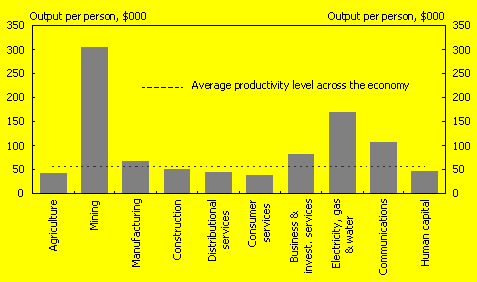Part I: Overview
Part II: The outlook for the international economy
Part III: The outlook for the domestic economy
Part IV: Uncertainties
The following is a reprint of Statement 3, Economic Outlook, from Budget Paper No. 1: Budget Strategy and Outlook 2001-02.
Economic outlook
Part I: Overview
Economic growth in Australia in 2001-02 is forecast to rebound quite strongly, driven by a turn around in residential construction. Employment growth is expected to be subdued with the unemployment rate averaging around 7 per cent, while inflation is forecast to decline and the current account deficit to be well below the average of the last decade. World growth is expected to weaken in 2001 to a little below historical averages, although there are significant downside risks.
In 2001-02, economic growth in Australia is forecast to be around 3¼ per cent in year-average terms and a strong 4 per cent through the year to the June quarter 2002. Residential construction is expected to contribute strongly to growth in 2001-02, with moderate growth in household consumption, business investment and net exports. Average unemployment rates are forecast to be slightly higher than recent levels, with inflation declining and the current account deficit well below its decade average.
Following three years of very strong economic growth in excess of 4 per cent per annum, the Australian economy slowed sharply in the second half of 2000. The weakness was concentrated in the residential construction sector, in part reflecting an unwinding of the bring-forward of residential construction into the first half of 2000, ahead of the introduction of The New Tax System. The downturn in this sector had flow-on effects to other parts of the economy through its impact on employment, consumer spending and consumer and business sentiment. At the same time, net exports contributed strongly to growth in 2000-01, buoyed by the lower exchange rate and the Olympics, despite a deteriorating international outlook and adverse seasonal conditions in the farm sector.
Given the weakness in the second half of 2000 and subdued growth expected in the first half of 2001, economic growth is now expected to be around 2 per cent in 2000-01 in year-average terms, and around 1 per cent in through-the-year terms.
The outlook for world growth has deteriorated since late 2000, led by a sharp slowdown in the United States (US) and weaker conditions in Japan. The outlook for growth in countries with close linkages to the US - such as the non-Japan East Asian economies - has also weakened. Europe is likely to be less affected by a slowdown in the US and is expected to continue to grow at a solid pace. Overall, the global economy is expected to grow by around 3¼ per cent in 2001, down sharply from 4.8 per cent in 2000, although only a little below the long-run historical average. Nevertheless, there are significant downside risks to growth in the US and Japan. Slower than forecast growth in these countries would result in weaker growth in East Asia and a more broadly based global slowdown.
Despite the slower world growth expected in 2001, net exports are estimated to contribute strongly to overall economic growth in Australia in 2000-01, with a further modest positive contribution expected in 2001-02. The exchange rate has helped boost the competitiveness of many of Australia's export and import competing industries. Australia's current account deficit (CAD) is forecast to be around 3 per cent of gross domestic product (GDP) in both 2000-01 and 2001-02. At these forecast levels, the CAD will be down markedly from 5.3 per cent of GDP in 1999-2000 and well below its average of the 1990s. In addition to the stronger balance of trade, the lower CAD also reflects a decline in the net income deficit (NID) in response to lower world and domestic interest rates and reduced margins between Australian and world investment returns.
Gross national expenditure is forecast to grow at a moderate rate of around 3 per cent in 2001-02, compared with less than 1 per cent in 2000-01. Residential construction is expected to grow by around 5 per cent in year-average terms in 2001-02, following a marked decline of around 25 per cent in 2000-01, with the turn around supported by recent reductions in interest rates and the Government's more generous First Home Owners Scheme. The recovery in this sector is expected to gather strength as 2001-02 proceeds, with through-the-year growth of around 14 per cent. Modest growth is also expected to resume in non-residential construction, particularly engineering construction, following several years of decline since the recent peak in 1998-99.
Household consumption expenditure is forecast to increase by around 3 per cent in 2001-02, a little faster than in 2000-01 but well below the very rapid growth experienced in the latter part of the 1990s (which was buoyed by strong growth in asset prices and household wealth). Household consumption will be supported by lower interest rates and a forecast gradual easing in petrol prices.
Employment growth in 2001-02 is expected to be slower than in recent years but grow at around 1 per cent in year-average terms and around 1½ per cent through the year. This largely reflects the lagged effects of slower overall economic growth in 2000-01, particularly the downturn in the labour intensive construction sector. The unemployment rate is expected to increase slightly, to average around 7 per cent in 2001-02 and in the June quarter 2002. This follows a period of declining unemployment which carried the unemployment rate down to around decade lows. Prospects are sound for a resumption in the downward trend in unemployment over the medium term as the construction sector recovers and overall economic growth strengthens.
Inflation is forecast to decline in 2001-02, with the headline consumer price index (CPI) rising by around 2 per cent in both year-average and through-the-year terms. The abolition of Financial Institutions Duty and other elements of The New Tax System will put downward pressure on consumer prices in 2001-02 and the forecasts also incorporate a slight easing in petrol prices in line with an expected downward trend in world oil prices.
From a domestic perspective, a key uncertainty relates to the possibility that the recent downward trend in business and consumer sentiment is sustained over coming quarters. This poses a downside risk to the forecasts for business investment and consumption. On the other hand, there is a possibility that the lower exchange rate and reductions in interest rates will provide a greater stimulus to economic growth than has been incorporated into the forecasts.
Table 1: Domestic economy forecasts(a)
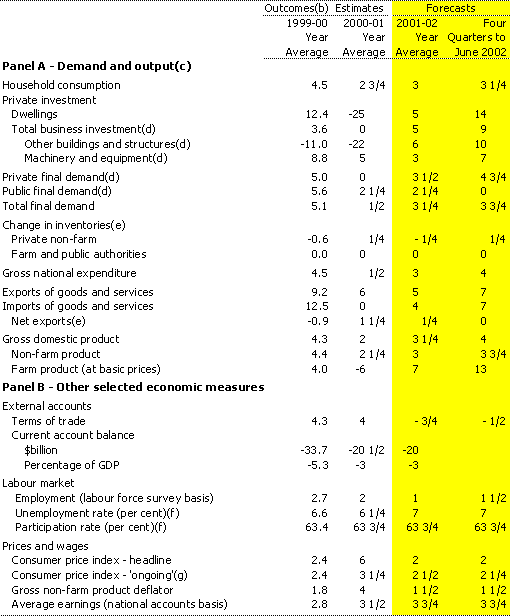
(a) Percentage change on preceding year unless otherwise indicated.
(b) Calculated using original data.
(c) Chain volume measure.
(d) Excluding private sector net purchases of second-hand public sector assets.
(e) Percentage point contribution to growth in GDP.
(f) The estimate in the final column represents the forecast level in the June quarter 2002.
(g) The `ongoing' CPI is the headline measure abstracting from the impact of The New Tax System.
Part II: The outlook for the international economy
The world economy grew by an estimated 4.8 per cent in 2000, up from 3.5 per cent growth in 1999 and well above long-term average growth rates. However, economic growth slowed through the second half of 2000 and is expected to be significantly weaker in 2001 at about 3¼ per cent, although this is only a little below the long-run historical average. The pace of growth is expected to pick up later in 2001 and increase to around 4 per cent in 2002 (Chart 1).
Chart 1: Annual growth in world GDP(a)
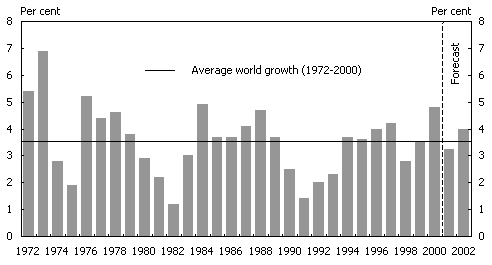
(a) World GDP growth rates are calculated using GDP weights based on purchasing power parity.
Source: Various national statistical publications, International Monetary Fund (IMF) and Treasury.
The slowing in world economic growth in the second half of 2000 reflected the restraining influence of earlier monetary tightenings, the rise in oil prices that reduced business and household purchasing power, and falls in equity prices, particularly in high-technology stocks.
The slowing in growth was particularly pronounced in the US. Following very rapid growth in the first half of 2000, household consumption slowed and production and investment eased in manufacturing industries following the build-up of inventories and capacity earlier in the year. Growth also softened in Europe, and the nascent recovery in Japan stalled. Activity in non-Japan East Asia was adversely affected by slowing US growth as the year ended.
World growth is expected to pick up as 2001 progresses, supported by a recovery in the US economy over the course of the year, solid growth in Europe and continued, albeit slower, growth in East Asian economies, particularly China. With the Japanese economy remaining sluggish, economic growth in Australia's main export markets is expected to be around 2¾ per cent in 2001, down sharply from 5 per cent in 2000, but well above the fall of 0.5 per cent recorded in 1998, during the Asian financial crisis.
In 2002, world growth is expected to rise to around 4 per cent, underpinned by gathering momentum in the US and stronger growth in the East Asian economies. However, the slow pace of growth expected in Japan points to Australia's export market growth being around 3½ per cent.
World inflation is expected to remain subdued with slower growth in the major economies easing capacity constraints and moderating price pressures. Ongoing productivity gains and increasingly competitive trading environments should also help contain inflation as growth picks up in 2002.
World oil prices have declined significantly over the past six months, suggesting that the risks to world activity and inflation from this source have abated somewhat. Prices are expected to continue to ease, in line with the weaker outlook for the world economy in 2001. Crude oil prices are now expected to decline from a world trade weighted1 average of US$27.6 per barrel in 2000 to around US$23¼ per barrel in 2001, and US$22 per barrel in 2002.
Oil prices are likely to remain volatile in the short term, reflecting uncertainty about the action of key producers and the strength of world demand. In particular, the actions of the Organisation of Petroleum Exporting Countries - which has already cut production by 2.5 million barrels per day thus far in 2001 - in the face of falling demand and prices, create some uncertainty around the forecast.
Growth in the United States was 5 per cent in 2000, although the rapid growth of the first half gave way abruptly to very modest rates in the second half of the year. Growth is expected to average around 1½ per cent in 2001 before rising to around 3¼ per cent in 2002.
The first half of 2000 was marked by a surge in business and consumer spending and a continuation of the same supply-side forces that have propelled the economy over the past few years: ongoing realisation of synergies from new technology and improved business practices, high levels of investment and elevated rates of productivity growth. In the second half of 2000, the situation changed. Equity markets adjusted downwards (particularly in high technology), consumption slowed, inventories grew, production weakened particularly in the manufacturing sector, and some capital spending was put on hold. The new technologies and business practices, which had underpinned the expansion, appeared to contribute to a more rapid pass through of the change in conditions than in the past.
The extent and duration of the slowdown in the US is expected to be mild compared with previous episodes, moderated by relatively sound underlying macroeconomic conditions and supportive policy settings. Growth is expected to be weak in the first half of 2001 as inventories and excess capacity in some industries are worked off, but should recover quickly in the second half of the year and into 2002. Consumer spending is expected to be supported by ongoing growth in income, still relatively high levels of consumer confidence, and by recent interest rate cuts and the prospect of tax cuts later in the year. Investment in housing appears to have picked up in the first part of 2001 and other investment should be supported in the longer term by productivity growth and prospects of attractive returns on high-tech investment. Nevertheless, risks around the US growth forecasts are substantial, with any significant deviations in US growth from the forecast levels having the potential to markedly affect overall world growth (Box 1).
Table 2: Annual growth in GDP for selected countries and groupings(a)(b)

(a) Percentage change on previous year.
(b) Growth rates for the World, the Organisation for Economic Co-operation and Development (OECD), the European Union (EU), and non-Japan East Asia are calculated using GDP weights based on purchasing power parity.
(c) Treasury estimates of World, OECD and EU growth rates.
(d) The OECD comprises the United States, Japan, Germany, France, Italy, the United Kingdom, Canada, Australia, Austria, Belgium, the Czech Republic, Denmark, Finland, Greece, Hungary, Iceland, Ireland, Korea, Luxembourg, Mexico, the Netherlands, New Zealand, Norway, Poland, Portugal, Spain, Sweden, Switzerland, Turkey and includes Slovakia from 2001.
(e) Export trade-weighted basis.
(f) Non-Japan East Asia comprises Korea, Singapore, Taiwan, Hong Kong, China, Indonesia, Malaysia, Thailand, and the Philippines.
Source: Various national statistical publications, IMF and Treasury.
Japan's economy grew by 1.7 per cent in 2000, although uncertainty about the sustainability of the expansion remains. Growth is expected to be uneven in 2001 with last year's fiscal package likely to raise public investment during the first half of the year, but with the boost to activity tapering off in the second half of the year as public spending declines. Consumption is likely to remain subdued and investment is expected to ease through 2001 as slower world growth and weaker demand for high-tech prod
ucts reduce exports and weaken the outlook for corporate profits. The sharp decline in equity prices over the past year is also likely to undermine business confidence and the investment outlook. For 2001 as a whole, growth is expected to average around ¾ per cent, before picking up to around 1½ per cent in 2002 as the global economy strengthens. Sustained recovery in Japan continues to be constrained by high levels of bad debts in the banking system. The new Government has expressed a commitment to progressing further reforms, including in the financial sector.
Growth in the euro area strengthened in 2000, rising to 3.4 per cent, buoyed by strong domestic and external demand. For 2001, growth is expected to moderate in the face of a less supportive global environment. However, the euro area appears to be less affected by the downturn in the US than some other regions and the effects are likely to be more muted. Consumption is expected to be underpinned by rising incomes, recent tax cuts and relatively high levels of consumer confidence. Investment, although adversely affected by weaker export earnings and higher energy prices, is likely to be supported by recent corporate tax cuts and relatively high levels of capacity utilisation. In 2001, growth in the euro area is expected to be around 2½ per cent, with slightly higher growth expected in 2002 at around 2¾ per cent, as world economic conditions improve. Growth in the United Kingdom is expected to be more affected by the slowdown in the US and problems associated with foot and mouth disease, with growth slowing to 2¼ per cent in 2001, before picking up to 2¾ per cent in 2002 on the back of stronger world growth and supportive macroeconomic policy.
The non-Japan East Asia region grew strongly in 2000, supported by strong export demand and rising domestic demand. The region benefited from the strong growth in the world economy and particularly from the upturn in demand for electronics in the US, Europe and Japan.
Growth is expected to slow in 2001 with the slowdown in the US and continued weakness in Japan expected to reduce demand for exports, particularly electronics, industrial machinery and automobiles which have been a cornerstone of the expansion. The impact is likely to be more pronounced for countries such as Taiwan, Singapore and Korea which have a high electronics component in their export base.
Unfavourable domestic factors are also likely to weigh heavily on the immediate outlook for the region, particularly in Indonesia, Thailand and the Philippines. However, foreign exchange reserves are generally higher than immediately preceding the Asian crisis, external positions have improved, and speculative capital inflow has been limited, leaving countries less vulnerable to unfavourable shifts of sentiment and capital flight.
Growth in non-Japan East Asia is forecast to decline from 7.4 per cent in 2000 to around 5¾ per cent in 2001 before picking up to 6½ per cent in 2002, in line with the expected recovery in the US. Excluding China (which continues to grow strongly), growth in the region is forecast to be 3½ per cent in 2001 before rising to 4¾ per cent in 2002.
Other emerging market economies grew strongly in 2000, but growth is likely to moderate in 2001. Financial and economic conditions remain fragile and they remain vulnerable to any further weakening in global conditions and/or a deterioration in sentiment towards emerging markets.
Part III: The outlook for the domestic economy
Key assumptions
In framing the forecasts for the domestic economy the exchange rate is assumed, as is usual practice, to remain unchanged from the average levels reached in recent months, at around US52½c and around 50 against the trade weighted index (TWI). On the basis of these assumptions, the exchange rate would be lower on average in 2001-02 than in 2000-01, and significantly lower than its average level of around US63c and 55 against the TWI in 1999-2000, helping to produce a solid net export performance in the face of slower world growth.
The forecasts take into account the reductions in official interest rates since February 2001. The reductions in interest rates are expected to be supportive of
domestic demand, especially residential investment and household consumption spending (in particular, on consumer durables). Although the timing and magnitude of this effect is uncertain, most of the impact from lower interest rates is expected to be felt in 2001-02.
The forecast fall in farm production in 2000-01 largely reflects a combination of very dry conditions in some areas and severe flooding in others. An assumed return to normal seasonal conditions in 2001-02 would see stronger farm production contributing to overall economic growth.
Demand and output
In 2001-02, economic growth in Australia is forecast to be around 3¼ per cent in year-average terms and a strong 4 per cent through the year to the June quarter 2002. Average unemployment rates are forecast to be slightly higher than recent levels at around 7 per cent, with inflation declining relative to 2000-01 and the CAD well below its average level of the 1990s.
Gross national expenditure is forecast to grow at a moderate rate of around 3 per cent in 2001-02, following growth of less than 1 per cent in 2000-01. Residential construction is expected to contribute strongly to growth, with moderate growth in household consumption, business investment and net exports (Chart 2).
Residential construction is expected to grow by around 5 per cent in year-average terms in 2001-02, following a large decline of around 25 per cent in 2000-01, with the turn around supported by recent reductions in interest rates and the Government's more generous First Home Owners Scheme. The recovery in this sector is expected to gather strength as 2001-02 proceeds, with through-the-year growth of around 14 per cent. Modest growth is also expected to resume in non-residential construction, particularly engineering construction, following several years of decline since the recent peak in 1998-99.
Following the weakness in the second half of 2000 and subdued growth expected in the first half of 2001, economic growth is now expected to be around 2 per cent in 2000-01 in year-average terms and around 1 per cent in through-the-year terms.
Chart 2: Contributions to GDP growth
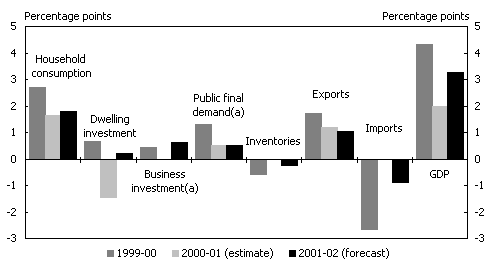
(a) Excluding private sector net purchases of second-hand public sector assets.
Source: Australian Bureau of Statistics (ABS) Cat. No. 5206.0 and Treasury.
Household consumption
Household consumption is forecast to increase by around 3 per cent in 2001-02, a little stronger than the estimate of 2¾ per cent for 2000-01 (Chart 3). This follows a six year period where consumption growth averaged a very strong 4½ per cent per annum.
Chart 3: Annual growth in real household consumption
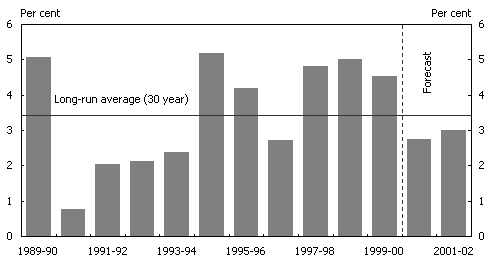
Source: ABS Cat. No. 5206.0 and Treasury.
Real household disposable income in 2000-01 has been boosted by the income tax cuts and increases in benefits flowing from The New Tax System (after an allowance for the associated increases in indirect taxes). However, the beneficial impact of these tax cuts on consumption expenditure was offset to some extent in the latter part of 2000 by the effects of rising interest rates during 2000 and rising petrol prices. Slower employment growth in 2000-01 also had a moderating effect on the growth in real household income and consumption. In addition, the strong accumulation of wealth experienced over recent years (Chart 4) did not continue to the same extent in 2000-01, with relatively steady share prices, and with house prices declining in some areas and rising less quickly than previously in other areas.
The significant interest rate reductions since early 2001 are likely to give some boost to consumption growth in 2001-02, as will the expected gradual downward trend in petrol prices. On the other hand, subdued employment growth will continue to have a moderating effect on the growth in real household income in 2001-02.
Chart 4: Annual growth in private sector wealth(a)
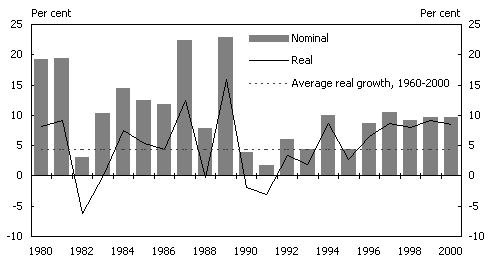
(a) June 30 estimates.
Source: Treasury.
There are few signs of major imbalances in the balance sheet of the household sector, suggesting that the household sector's net financial position should not act as a major constraint on consumption growth over the forecast horizon. Household borrowing has been strong in recent years, partially reflecting the continuing impact of financial deregulation on the availability of credit and lower interest rates. This has increased the debt-to-disposable income ratio to a little over 100 per cent, close to the average of other developed economies. However, the growth in household debt has been broadly matched by an increase in assets held by households, with the household debt-to-assets ratio showing only a gradual increase over recent years. Further, the household debt servicing ratio remains at a relatively modest level by historical standards (see Chart 5), well below the peak in the late 1980s, and is likely to fall during 2001 in response to recent declines in interest rates.
Measures of consumer sentiment have been particularly volatile over the last year, with the Westpac-Melbourne Institute index falling by around 15 per cent prior to the introduction of The New Tax System and then rebounding to previous levels, as the uncertainty surrounding the introduction of The New Tax System abated. The consumer sentiment index has trended lower over recent months, although with a significant rebound in May. Nevertheless, it is too early yet for the full impact of lower interest rates to be reflected in the survey responses. It is also noteworthy that retail sales increased strongly in the March quarter 2001 (by around 1.9 per cent in real terms), at a time when measures of consumer sentiment were declining.
An extended period of low consumer sentiment represents a downside risk to the consumption growth forecasts, although the recent reductions in interest rates should be supportive of higher confidence levels.
Chart 5: Household debt servicing ratio
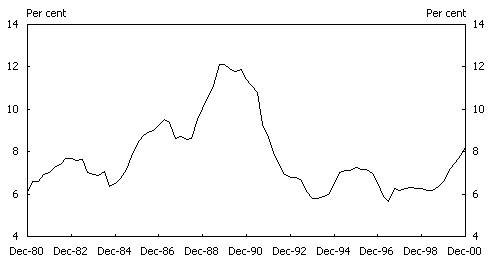
(a) Household (including unincorporated enterprises) debt interest payments as a proportion of household disposable income.
Source: ABS Cat. No. 5206.0.
Dwelling investment
Following several years of strong growth, dwelling investment is expected to fall by around 25 per cent in 2000-01 in year-average terms, before returning to a positive rate of growth later in 2001.
In 1999-2000, building activity rose strongly to its highest level as a share of GDP in almost 20 years, as home builders and renovators brought forward activity ahead of the introduction of The New Tax System. This bring-forward of activity was unwound in the second half of 2000 which, combined with the effects of higher interest rates, saw activity in this sector decline by around 35 per cent over the September and December quarters of 2000 (Chart 6). This decline in building activity, in turn, contributed to weaker employment and household c
onsumption spending.
In 2001-02, dwelling investment is expected to rebound significantly, with forecast growth of around 5 per cent in year-average terms and around 14 per cent in through-the-year terms. Strong growth is expected to be driven largely by improved housing affordability and by the Government's more generous First Home Owners Scheme. Recent declines in interest rates should see housing affordability improve through 2001. The First Home Owners Scheme, which encourages the construction of new dwellings through the payment of a $14,000 grant to first home buyers, should also provide a targeted, short-term boost to building activity in 2001-02.
There is a greater than normal degree of uncertainty surrounding the timing and extent of the recovery in dwelling investment. The Government's more generous First Home Owners Scheme and the recent reductions in interest rates should provide a significant boost to activity in the sector, although the timing and magnitude of this boost is difficult to assess. Early indications suggest strong interest from home buyers resulting from the First Home Owners Scheme.
Chart 6: Growth in dwelling investment
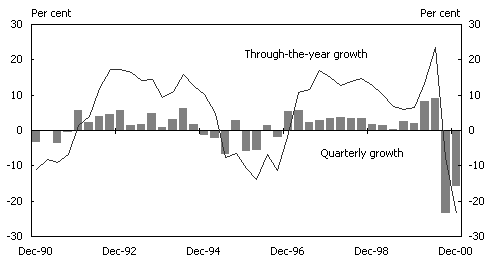
Source: ABS Cat. No. 5206.0.
Business investment
New business investment2 is expected to grow by around 5 per cent in 2001-02, following approximately zero growth in 2000-01 (Chart 7). Through the year to the June quarter 2002, new business investment is expected to grow by around 9 per cent. The solid outlook for business investment reflects sound fundamentals: short and long-term interest rates are near historical lows; corporate profitability (despite recent declines) remains around historically high levels as a share of GDP, and is particularly strong in the mining sector which is highly capital intensive; and the decline in the exchange rate over recent quarters will give many Australian industries an important buffer against the effects of slower world growth. Despite the forecast solid increase in business investment in 2001-02, the level of business investment would remain slightly below longer run averages as a share of GDP, following a small fall in 2000-01.
New investment in plant and equipment is expected to grow by around 3 per cent in 2001-02, and a strong 7 per cent through the year to the June quarter 2002, following estimated growth of around 5 per cent in 2000-01. The outlook for investment in plant and equipment is partially underpinned by expected investment in the mining sector. After a couple of very weak years during and immediately following the Asian crisis, conditions in the mining sector are conducive to investment, with record levels of profitability boosted by higher prices for a range of commodities and the decline in the exchange rate. Firms' first investment intentions for 2001-02, as reported in the ABS capital expenditure survey, were quite strong, although early estimates only provide a broad indication of likely outcomes. Allowing for some impact from lower levels of business confidence experienced over recent quarters on realisation ratios applied to investment intentions, the investment intentions data point to solid growth in plant and equipment investment in 2001-02.
Chart 7: Annual growth in new business investment(a)
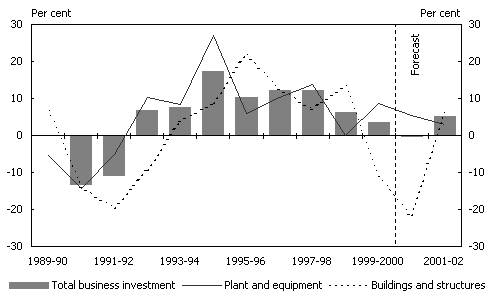
(a) Excluding net purchases of second-hand public sector assets.
Source: ABS Cat No. 5206.0 and Treasury.
The risks around the outlook for plant and equipment investment in 2001-02 appear to be balanced. On the one hand, slower domestic and world growth may point to a weaker outlook than forecast, particularly if business confidence falls in response to this uncertain outlook. While profits in aggregate have been around historically high levels, there is anecdotal evidence that margins in some sectors may have been affected by the lower Australian dollar, high energy and fuel costs, new tax payment arrangements and weaker demand. On the other hand, relatively low short and long-term interest rates, lower plant and equipment prices as a result of the introduction of The New Tax System, and the potential for investment by the mining and resource sectors over the medium term are supportive of strong investment. There is also some potential for stronger than forecast investment in 2001-02 if business confidence rebounds sharply from its current level.
New investment in buildings and structures is expected to grow by around 6 per cent in 2001-02 and a strong 10 per cent through the year to the June quarter 2002. This follows an estimated decline of 22 per cent in 2000-01, mainly associated with the completion of Olympics-related projects. Strong growth in engineering construction is expected to underpin growth in investment in buildings and structures in 2001-02, as a number of new projects in the mining and resource sectors, and several power generation projects, commence during the year. A stabilisation in the level of non-residential building approvals, commencements and work-yet-to-be-done suggests that activity in this sector may have bottomed, following two years of decline.
Investment in intangible fixed assets (that is, computer software, mineral exploration rights and artistic originals) is expected to grow strongly in 2001-02, although at a slower rate than in 1999-2000 and 2000-01. The outlook for intangible fixed assets is dominated by expected strong growth in software investment, which now comprises over 10 per cent of total new business investment. Some easing in growth of software investment is expected in 2001-02, following the completion of work relating to the new tax arrangements in 2000, and Y2K-related work in 1999.
Inventories
Private non-farm inventories are expected to contribute around a ¼ of a percentage point to growth in 2000-01. In the first half of 2000, there appears to have been an unanticipated run-down in inventories, especially in the retail sector, as sales were brought forward ahead of the introduction of The New Tax System. In turn, there was some rebuilding of inventory levels in the second half of 2000 as this net bring-forward of sales was unwound. However, after making an allowance for this effect, there appears to have been a modest build-up in inventory levels in the second half of 2000, due to weaker than expected growth in sales.
Private non-farm inventories are expected to subtract around a ¼ of a percentage point from GDP growth in 2001-02, as the modest build-up in inventories in the second half of 2000 is gradually unwound over 2001, and more generally as firms continue to manage down inventory-to-sales ratios to increase profitability. However, there is a risk that the build-up in inventories may be unwound more quickly, especially if the recent falls in business sentiment are sustained.
Public final demand
In 2001-02, real public final expenditure3 is anticipated to grow by around 2¼ per cent in year-average terms, similar to the outcome expected in 2000-01, but well below the 5.6 per cent growth recorded in 1999-2000. The moderation relative to 1999-2000 reflects the winding down of expenditure related to the peacekeeping mission in East Timor; the start-up costs associated with tax reform; and the completion of
large infrastructure projects in some States (including the Olympics). This has been partially offset at the Commonwealth level by the new spending initiatives on research and development, roads and defence that are expected to commence in 2001-02.
Growth in consumption at the State level is expected to be steady, with a fall in consumption following the Olympics offset by increased spending on roads and wage costs. An expected fall in State underlying investment reflects the completion of a large number of infrastructure projects in 2000-01 and decreased investment spending in 2001-02.
Net exports and the current account balance
The CAD is forecast to decline sharply from 5.3 per cent of GDP in 1999-2000 to around 3 per cent of GDP in 2000-01 and 2001-02. The decline in the CAD relative to 1999-2000 is expected to be driven by a stronger trading performance in volume terms, a rise in the terms of trade and a lower NID. At these levels, the CAD would be well below its average level as a share of GDP during the 1990s, and around half its earlier peaks.
Net exports
Net exports are expected to contribute a large 1¼ percentage points to GDP growth in 2000-01, but slower world growth in 2001 will have a significant impact on exports in 2001-02. However, net exports are still expected to contribute around ¼ of a percentage point to GDP growth in 2001-02, reflecting the assumed lower average exchange rate in 2001-02 and the impact of modest growth in domestic demand on imports.
In 2001-02, export volume growth is expected to be a solid 5 per cent, following an estimated 6 per cent growth in 2000-01. These growth rates are only a little below trend, reflecting the impact of slower world growth in 2001 on Australia's export volumes being substantially offset by a lower average exchange rate. Export growth in 2001-02 is expected to be underpinned by strong growth in non-rural commodity exports, reflecting the continued ramp-up of production from recently completed projects.
Farm production is expected to fall by around 6 per cent in 2000-01 due to adverse seasonal conditions. In 2001-02, farm production is expected to grow strongly, by around 7 per cent (well above trend), due to the assumed return to average seasonal conditions. Rural export volumes are not expected to fall by as much as farm production in 2000-01, as stocks - particularly wool and wheat - are drawn down to meet demand. As a result, rural export volumes are not expected to rebound as strongly as farm production in 2001-02.
The impact of slower world growth - in particular in Australia's major trading partners - is expected to be most apparent in lower growth in elaborately transformed manufactures (ETMs) and services exports. However, the lower average exchange rate should partially offset this by providing a boost to Australia's competitiveness, enabling Australian exporters to increase their market share. As a result, both services (abstracting from the Olympics) and ETM export volumes are expected to continue to grow solidly in 2001-02, albeit at rates somewhat below trend.
Import volumes are expected to grow by 4 per cent in 2001-02, up from around zero growth in 2000-01, reflecting strengthening - but still below trend - domestic demand growth and more modest growth in import prices in Australian dollar terms than in 2000-01. Nevertheless, in both years, import volume growth is expected to be well below trend growth rates.
The terms of trade
The terms of trade are expected to increase by a strong 4 per cent in 2000-01, to be around the highest level in a decade. Only a slight decline (¾ per cent) from these levels is forecast in 2001-02, despite slower expected world growth. This slight decline reflects a modest fall in the world price of Australia's exports, partly offset by continued weakness in the world price of Australia's imports.
In currency neutral (Special Drawing Rights (SDR)) terms, Australia's non-rural commodity export prices - as measured by the Reserve Bank of Australia's commodity price index - are expected to continue to grow in 2001-02, following strong growth in 2000-01. Underlying this forecast are strong increases in negotiated contract prices for bulk commodities being partially offset by weaker prices for base metals and mineral fuels. Contract prices for steaming coal have recently increased by around 20 per cent in US dollar terms, coking coal by around 11 per cent and iron ore by around 4 per cent.
Some moderation in aggregate rural prices in SDR terms from recent high levels is anticipated, reflecting an expected rise in world agricultural production in 2001-02 (in part driven by the continued high level of agricultural subsidies in developed countries) and continued high levels of world stocks. This points to subdued world prices in 2001-02, particularly for wheat and cotton. Nevertheless, world prices for beef and wool - two of Australia's key rural exports - are expected to increase slightly in 2001-02, building on strong gains in 2000-01, to be at their highest level in two decades in Australian dollar terms. This reflects a relatively tight supply/demand balance in both markets.
In Australian dollar terms, rural commodity prices are expected to remain around historically high levels over the forecast period. While adverse seasonal conditions have seen farm production fall by around 6 per cent in 2000-01, a return to average seasonal conditions is expected to see farm production increase by 7 per cent in 2001-02. The relatively unusual combination of high prices and strong production should see farm incomes increase to historically high levels in 2001-02.
The current account deficit
The CAD is forecast to decline sharply in 2000-01, to 3 per cent of GDP, down from 5.3 per cent of GDP in 1999-2000. The decline in the CAD is expected to be driven by a stronger trading performance in volume terms, a rise in the terms of trade and a lower NID. In 2001-02, the CAD is expected to remain around 3 per cent of GDP.
Chart 8: Contributions to the current account deficit
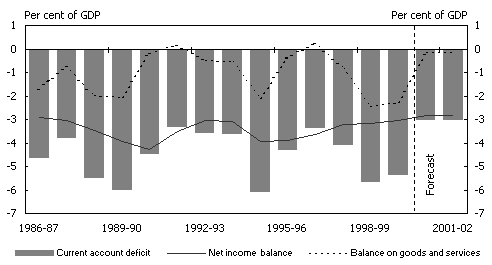
Source: ABS Cat. No. 5302.0 and 5206.0 and Treasury.
The NID is forecast to remain a little below 3 per cent of GDP, despite a continued (albeit more moderate) build up in Australia's net foreign liabilities as a share of GDP. This outcome reflects lower Australian and world interest rates, and the significant narrowing in the difference between the yield on foreign investment in Australia and the yield on Australian investment abroad over recent years. Recent trends in the NID are discussed in more detail in the Centenary edition of the Economic Roundup.
The labour market
Employment growth in 2001-02 is expected to be slower than in recent years at around 1 per cent in year-average terms and around 1½ per cent through the year. This largely reflects the lagged effects of slower overall economic growth in 2000-01, particularly the downturn in the labour intensive construction sector (Box 2).
Employment in the construction sector declined by around 55,000 in total over the December 2000 and March 2001 quarters, with likely flow-on effects to other sectors, including employment in parts of the manufacturing sector involved in the production of building materials. These effects are ex
pected to be reversed gradually as the construction sector recovers during the course of 2001-02, with the turn around likely to be most apparent in the second half of the year.
Chart 9: Unemployment rate
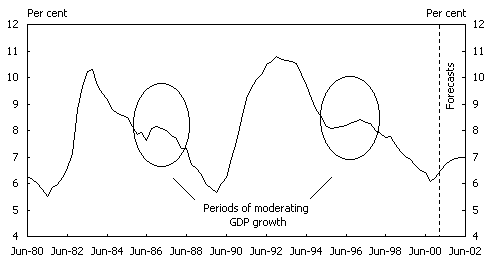
Source: ABS Cat. No. 6202.0 and Treasury.
The unemployment rate is expected to increase slightly from recent levels, to average around 7 per cent in 2001-02 as a whole and in the June quarter 2002. Monthly data are likely to vary significantly around these averages. Recent falls in the various job vacancy series suggest that weak employment outcomes are likely over coming months, which is expected to put some upward pressure on the unemployment rate. However, as in previous short periods of slower GDP growth (identified by the circled periods in Chart 9), the increase in the unemployment rate is expected to be relatively small and quite brief. Continued moderate growth in wages will help to limit the extent and duration of the rise in unemployment. Prospects are sound for a resumption of the downward trend in unemployment over the medium term as the construction sector recovers, overall economic growth strengthens and the benefits from earlier labour market reforms and more general microeconomic reforms, including taxation reform, continue to accrue.
Productivity growth (on a heads basis) is forecast to reach a cyclical low in 2000-01 before rebounding solidly in 2001-02 to 2¼ per cent. Some of the factors likely to influence the medium-term trends in productivity are discussed in Budget Paper No. 1, Statement 4.
|
Box 2: Sectoral differences in labour productivity in Australia Industries in Australia differ markedly in terms of their labour intensity and therefore their levels of labour productivity (Chart 10). For example, mining accounts for around 5 per cent of total output, but employs just 1 per cent of the workforce and therefore has a high level of labour productivity (output of around $300,000 per person employed in the industry) and is relatively capital intensive. In contrast, construction is relatively labour intensive with levels of labour productivity (output of around $50,000 per person employed in the industry) a little below the economy-wide average. Chart 10: Labour productivity by industry(a)4
(a) The chart shows average levels of productivity over the years 1996-97 to 1999-2000. Source: ABS Cat. No. 5206.0 and 6203.0. Continued... |
Wages
Wages have continued to grow at a moderate pace in 2000-01, consistent with slower economic and employment growth and the moderate increase in unemployment. Importantly, there has been little evidence to date of widespread wage increases in response to price changes following the introduction of The New Tax System.
Average earnings growth on a national accounts basis (AENA) is expected to be a moderate 3½ per cent in 2000-01. Abstracting from the increase in the superannuation guarantee charge on 1 July 2000, AENA is expected to grow by 3 per cent in 2000-01.
In 2001-02, growth in AENA is expected to increase to 3¾ per cent, as economic growth strengthens and is reflected in slightly firmer labour market outcomes as the year progresses. The forecast incorporates the recent `Living Wage Case' decision.
The pace of the pick up in economic activity and the timing of its impact on the labour market represent a key source of uncertainty around the wages outlook.
While the introduction of The New Tax System does not appear to have influenced wages growth to date, there remains a residual risk to wages over the forecast period (for example, if union campaigns were to be successful). Recent enterprise bargaining data indicate that the proportion of employees covered by agreements that include inflation-related clauses has increased. However, there is no rationale for higher wages to compensate for the price effects of The New Tax System, given the significant personal income tax cuts and increases in benefits contained in the package.
Prices
In 2000-01, `ongoing' inflation (that is, inflation excluding the impact of The New Tax System) is expected to be around 3¼ per cent in both year-average and through-the-year terms. The increase in `ongoing' inflation relative to the 1999-2000 outcome of 2.4 per cent in year-average terms largely reflects the effect of the increase in petrol prices over calendar year 2000.
The New Tax System is expected to increase the CPI by around 2½ per cent through the year to the June quarter 2001, with this effect having been felt largely in the September quarter 2000. Taking together the estimates of `ongoing' inflation and the impact of The New Tax System, the CPI is expected to increase by 6 per cent in year-average terms in 2000-01 and by 5¾ per cent through the year to the June quarter 2001.
The CPI increased by 1.1 per cent in the March quarter of 2001. This higher than expected outcome largely reflected the effect of flooding in northern New South Wales and southern Queensland on fruit and vegetable prices and the effect of increased world demand for Australian meat products. The sharp rise in fruit and vegetable prices is likely to be at least partly reversed in coming quarters as supply returns to more normal levels. There were also the usual seasonal increases in the price of education, pharmaceuticals and childcare. Petrol prices fell 3.7 per cent in the quarter, in response to lower world oil prices and the Government's decision to reduce excise on petrol (and abolish indexation) in early March. Looking through these influences, the CPI increased by a moderate 0.6 per cent in the March quarter, following the very low increase of 0.3 per cent in the December quarter.
Inflation is forecast to decline in 2001-02, with the headline CPI rising by around 2 per cent in both year-average and through-the-year terms. The abolition of Financial Institutions Duty (FID) and other elements of The New Tax System will put downward pressure on consumer prices in 2001-02 and the forecasts also incorporate an allowance for a slight easing in petrol prices in line with an expected downward trend in world oil prices. Wages growth is expected to remain moderate, at around 3¾ per cent, helping to ensure that growth in labour costs remains well contained. The inflation forecasts also make an allowance for some impact on consumer prices of the decline in the Australian dollar over recent
quarters.
Measures introduced as part of The New Tax System (including the abolition of FID and stamp duty on marketable securities from 1 July 2001, as well as the early introduction of input tax credits for motor vehicles) are expected to reduce the CPI by between a ¼ and a ½ of a percentage point in both year-average and through-the-year terms. Leaving aside this effect, `ongoing' inflation is expected to be around 2¼ per cent in the year to the June quarter 2002.
A number of key uncertainties surround the inflation outlook, particularly for 2001-02. If world oil prices or the value of the Australian dollar differ substantially from their assumed levels, this could pose risks to the inflation forecasts on both sides. The inflation forecasts are also based on the historical pass-through from exchange rates into the CPI. However, in recent years, exchange rate movements appear to have had less impact on the CPI than was the case on average over recent decades. If this reduced pass-through from the exchange rate to the CPI were to continue, inflation could be lower than forecast.
Part IV: Uncertainties
From a domestic perspective, a key uncertainty relates to the possibility that the recent downward trend in business and consumer sentiment is sustained over coming quarters. While the relationship between business and consumer sentiment measures and actual growth outcomes can be loose, if the recent falls in these measures were sustained there may be downside risk to the forecasts for business investment and consumption.
On the other hand, there is a possibility that the lower dollar and lower interest rates will provide a greater stimulus to economic growth than has been incorporated into the forecasts. There is also the potential for stronger than forecast investment and consumption in 2001-02 if business and consumer confidence were to rebound sharply from their current levels.
The dwelling sector is expected to rebound strongly in 2001-02, although, there is a greater than normal degree of uncertainty surrounding the timing and extent of this recovery. In particular, while the Government's more generous First Home Owners Scheme and the recent reductions in interest rates should provide a significant boost to activity in the sector, the timing and magnitude of this boost is difficult to assess.
The key international uncertainty is how the US economy will evolve over the next few quarters. The most likely outcome is that growth will slow in the first half of 2001 as excess inventories are unwound and excess capacity is pared back, but will pick up quickly once the adjustment is complete. In this case the impact on the rest of the world would be relatively mild and transitory. However, if falls in consumer and business confidence were to translate into weaker demand then the deterioration in confidence would likely become self-reinforcing and the outcome would be a deeper and more prolonged period of weakness than currently envisaged.
Japan and the non-Japan East Asian region would be adversely affected if a sharp and severe downturn in the US were to occur. The Japanese economy has been weak for some time, unable to gather momentum despite substantial fiscal stimulus. With short-term policy options now limited and unresolved problems in the financial and corporate sectors continuing to weigh heavily on consumer and business sentiment, Japan is exposed to any further deterioration in global economic conditions. Weaker external demand would see a further erosion of confidence and increase the chance that the economy would fall back into recession.
A sharper than forecast slowdown in the US and in Japan would adversely affect several regions, but especially non-Japan East Asia. Asian economies have relied heavily on export-led growth to support recovery over the past few years and are vulnerable to a broad based slowdown in global demand. The Asian economies have also become increasingly integrated with the US economy through the information technology production chain, and are exposed to a weaker US economy through this channel. With several Asian economies facing domestic problems and further progress on structural reforms necessary to strengthen their resilience to external shocks, there is a risk of substantial spillover effects in the region if economic conditions either in the US or Japan were to deteriorate substantially. However, the lower interest rates provide some relief and the gradual decline in oil prices is also helpful for oil importing countries.
A significant slowdown in the US economy, combined with weaker growth in East Asia would result in a more broadly based global slowdown. This would translate into some downside risk to the outlook for Australia's export growth, especially in 2001-02 and hence represents a downside risk to the outlook for Australia's GDP growth in that year.
1 The world trade weighted oil price is the average of the contract price of different types of oil, weighted by their share of the world oil trade (that is, between countries).
2 Private sector net purchases of second-hand public sector assets can have a significant impact on estimates of business investment and public final demand, despite the fact that these asset purchases have no impact on aggregate economic activity. Accordingly, the forecasts of new business investment abstract from these transactions.
3 The forecasts of public final expenditure abstract from private sector net purchases of second-hand public sector assets - see footnote 2.
4 The following industries are aggregations of `similar' ABS standard industry classifications: distributional services include wholesale trade, retail trade and transport and storage; business and investment-related services include finance and insurance, and property and business services; consumer services include accommodation, cafes and restaurants, cultural and recreational services, and personal and other services; and human capital services include government administration and defence, education, and health and community services.
